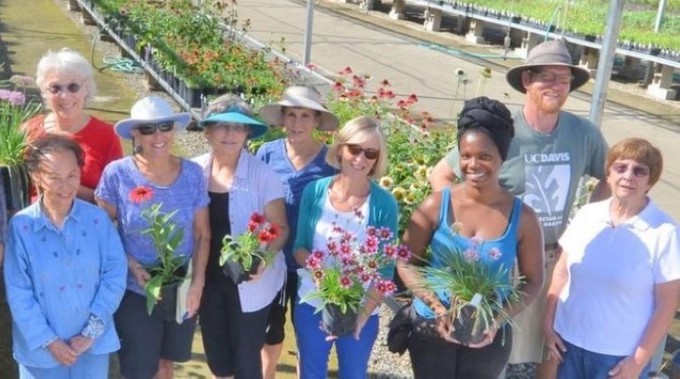
Get water-wise favorites and California natives in time for fall planting

Staff, students and volunteers are ready to help customers find the right plants for their landscapes at the UC Davis Arboretum Teaching Nursery. Courtesy of UC Davis Arboretum and Public Gardens https://arboretum.ucdavis.edu/plant-sales
Fall is the a perfect time to plant California natives and perennials. It’s also a wonderful time to shop for these plants.
With hundreds of drought-tolerant possibilities, UC Davis Arboretum’s Teaching Nursery hosts the first of three fall plant sales on Saturday, Sept. 30.
This first fall sale is a “split sale,” with the first two hours (9 to 11 a.m.) reserved for members of the Friends of the Arboretum. From 11 a.m. to 1 p.m., the sale is open to the public. Admission is free.
“Fall is the best time to plant!” says the nursery’s staff. “Shop our one-acre nursery to find an incredible selection of attractive, low-water plants perfect for our region.”
You won’t only take home great additions to your home landscape, you’ll be helping the Arboretum and UC Davis students.
“By choosing to shop with us, not only will you bring home beautiful plants that help support a sustainable environment, your purchases play a vital role in supporting the growth and care of our gardens, student environmental leadership opportunities, and free public programs,” says the staff.
“Discover the joys of gardening with plants that help heal our environment while nurturing our community!”
Not a Friends of the Arboretum member yet? No problem. New members can join at the gate (or online) and receive an immediate 10% discount.
Closed to the public since last spring, the large nursery is stuffed with plants including many Arboretum All-Stars, proven flowering plants that can thrive in Sacramento’s hot summers with less water.
Also available are a wide range of attractive Mediterranean perennials and California natives. Find easy-care shrubs, trees, ground covers, bulbs and more – all suited to our climate and low-water landscapes. Most selections also benefit pollinators.
Before heading to the nursery, check out the selection online in the Arboretum’s Plant Sale Photo Gallery.
A second split sale is planned for Saturday, Oct 21. The annual fall clearance sale – the Arboretum’s final plant sale of 2023 – is set for 9 a.m. to 1 p.m. Nov. 4.
The Arboretum Teaching Nursery is located on campus on Garrod Drive near the small animal veterinary hospital.
For details, directions and the Plant Sale Photo Gallery: https://arboretum.ucdavis.edu.
Comments
0 comments have been posted.Sacramento Digs Gardening to your inbox.
Food in My Back Yard Series
May 6: Maintain soil moisture with mulch for garden success
April 29: What's (already) wrong with my tomato plants?
April 22: Should you stock up on fertilizer? (Yes!)
April 15: Grow culinary herbs in containers
April 8: When to plant summer vegetables
April 1: Don't be fooled by these garden myths
March 25: Fertilizer tips: How to 'feed' your vegetables for healthy growth
March 18: Time to give vegetable seedlings some more space
March 11: Ways to win the fight against weeds
March 4: Potatoes from the garden
Feb. 25: Plant a fruit tree now -- for later
Feb. 18: How to squeeze more food into less space
Feb. 11: When to plant? Consider staggering your transplants
Feb. 4: Starting in seed starting
Sites We Like
Garden Checklist for week of May 4
Enjoy this spring weather – and get gardening!
* Plant, plant, plant! It’s prime planting season in the Sacramento area. Time to set out those tomato transplants along with peppers and eggplants. Pinch off any flowers on new transplants to make them concentrate on establishing roots instead of setting premature fruit.
* Direct-seed melons, cucumbers, summer squash, corn, radishes, pumpkins and annual herbs such as basil.
* Harvest cabbage, lettuce, peas and green onions.
* In the flower garden, direct-seed sunflowers, cosmos, salvia, zinnias, marigolds, celosia and asters. (You also can transplant seedlings for many of the same flowers.)
* Plant dahlia tubers. Other perennials to set out include verbena, coreopsis, coneflower and astilbe.
* Transplant petunias, marigolds and perennial flowers such as astilbe, columbine, coneflowers, coreopsis, dahlias, rudbeckia and verbena.
* Keep an eye out for slugs, snails, earwigs and aphids that want to dine on tender new growth.
* Feed summer bloomers with a balanced fertilizer.
* For continued bloom, cut off spent flowers on roses as well as other flowering plants.
* Add mulch to the garden to maintain moisture. Mulch also cuts down on weeds. But don’t let it mound around the stems or trunks of trees or shrubs. Leave about a 6-inch to 1-foot circle to avoid crown rot or other problems.